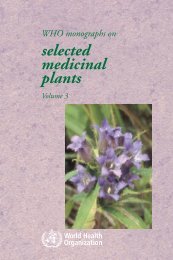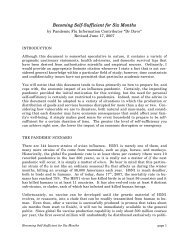Create successful ePaper yourself
Turn your PDF publications into a flip-book with our unique Google optimized e-Paper software.
WHITE SPORE PRINT<br />
contain dozens of specimens, and it is not uncommon to see the<br />
sides of old dead trees and rotten stumps almost covered with them.<br />
They are not injured by drying and will remain on a tree for<br />
weeks in perfectly good condition unless invaded by beetles. Because<br />
of their toughness they are more suitable for flavoring gravies<br />
and similar dishes than for solo consumption.<br />
GENUS Pleurotus<br />
Translated literally, the word Pleurotus means side ear, a term<br />
apt enough because some of the kinds included in this genus are<br />
more or less ear-like in shape and are attached to the wood from<br />
which they grow by means of a lateral, or side, stem. The genus is<br />
supposed to be recognized by (i) the white spores, (2) the stem<br />
attached at the side of the cap, or at least off center, and (3) the<br />
fleshy or tough texture of the cap, but actually there are no certain<br />
marks by means of which one can know the genus. Two of the<br />
common edible species, however, can be recognized easily.<br />
Eminently edible: PLEUROTUS OSTREATUS (Oyster<br />
Mushroom)<br />
The cap of this fungus (Figure 37) resembles an oyster in<br />
shape, whence the name, but the resemblance goes no farther, although<br />
the oyster mushroom makes excellent eating. Since it<br />
usually grows in clumps weighing a pound or more, each including<br />
five to ten fruit bodies, it is a good mushroom to become<br />
acquainted with. The cap is kidney- or oyster-shaped when viewed<br />
from above, with a short stem tapering downward from one side;<br />
it may be from 3 to 6 or 8 inches wide, projecting 3 to 5 inches<br />
outward from the place of attachment and sloping downward<br />
from the margin to the stem. The upper side is white or ivorycolored<br />
and quite smooth. The gills are white, and the white<br />
flesh is soft and spongy.<br />
The only complaints that might be made against this species<br />
63
















